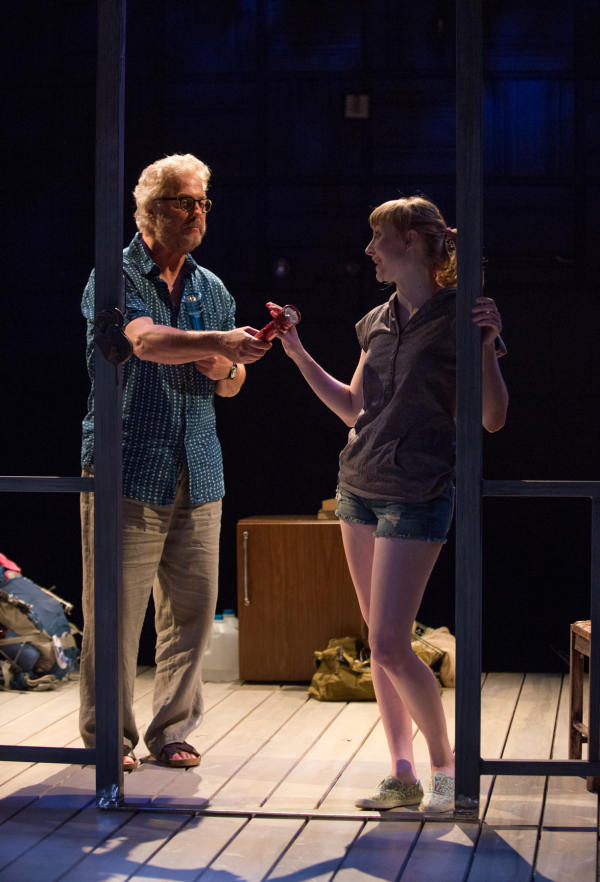Slowgirl

(© Michael Brosilow)
There may only be two characters in Slowgirl, but this lovely quiet drama by Greg Pierce, now playing at the Geffen Playhouse, feels well-populated. As Sterling and his 17-year-old niece Becky try to navigate some thorny emotional territory at a small house in a remote area of Costa Rica, they are most decidedly not alone. Between the jungle creatures scratching away on the roof or roaming the trails, and the weight of individuals from both characters’ pasts, solitude is at a premium. Which is by no means a bad thing.
Geffen Artistic Director Randall Arney is restaging Slowgirl following a summer 2013 run of the play at Steppenwolf Theatre where Arney formerly served as artistic director and company member. Also returning for the L.A. run are the production’s two Chicago-based actors, William Petersen and Rae Gray. The synchronicity between playwright, director, and performers is a joy to watch, particularly in a play that sees the necessity of filling silences. Although he can deliver larger ensemble dramas expertly, Arney excels at letting his players be miniaturists. Intimate, character-driven opuses like Slowgirl (or, in previous Geffen seasons, works by David Mamet and Connor McPherson) are right in his wheelhouse.
Becky is dispatched to Central America to spend a week with her uncle and godfather Sterling, who she has not seen in nine years. Although she digs the scenery and can use the rest, this is not entirely a vacation; Becky has been suspended from school because of an incident at a party and she is escaping to come to grips with the potential consequences. Sterling, a former attorney, fled to Costa Rica to escape some rocky incidents in his own past. The salty-tongued Becky recognizes, in her uncle, a sympathetic ear. No dummy, she also detects Sterling’s emotional barriers — and plows right on through them. The titular Slowgirl is an unflattering nickname for Becky’s classmate, Marybeth, back in Massachusetts.
For his part, Sterling loves his niece and wants desperately to help. But time and circumstances have turned an already soft and solitary man further inward. He can barely hug Becky, let alone complete a sentence to impart any wisdom. Still, Sterling proves to be a better listener than a man living in isolation probably should be, and he realizes that a pilgrimage to his walking labyrinth known as the Sanctuary might do some good. As the week draws on, the two draw slightly closer and walls begin to crack.
Audiences who know Petersen primarily from his years combing through DNA evidence as Gil Grissom on TV's CSI will appreciate his work here. Gray-haired and a bit paunchy, the actor fleshes out a character who is both secure in his choices and damaged. Sterling is a thinker who spends lengthy stretches of Slowgirl as the reactive straight man to Becky’s outbursts. Slowgirl is Becky’s play, and when it’s Gray’s turn to shine, Petersen yields the stage gracefully.
This happens often. Pierce has crafted a richly layered character in Becky, and Gray’s performance is superb. Here we have a young woman on the brink physically and emotionally, and Gray infuses her with a deft mixture of the I know best certainty that only a teen can deliver, and the vulnerability of a child who is completely out of her element. Seeing Gray’s Becky try to reach some kind of peace, we can’t help hoping Sterling will figure out how to ease her journey.
That Sterling’s house has no doors is evocative as well as symbolic. Set designer Takeshi Kata’s centerpiece is the skeletal frame of Sterling’s house. The ceiling is greened up a bit with some fern-like flora and Richard Woodbury’s sound design has critters chattering away. Otherwise, the visuals are spare. When Becky pronounces the Costa Rican landscape to be "so @ss-f*ck beautiful," we have to take her word for it.
In this delicate little tale, so exquisitely rendered by Arney and Co., Pierce advocates for the importance of leaving an opening. When a house has no doors, somebody or something will walk in, and broken people like Sterling and Becky can break a little more, before they start to mend.










